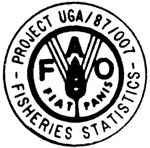
BY
J. IKWAPUT & J. WADANYA
16th – 17th August, 1990.
| Abstract |
| This report describes briefly the trip which was made to
Kalangala with the specific objectives to brief the Regional
Fisheries Officer and his survey team on the methodology and
procedures of the frame survey and to get it started. |
SEPTEMBER, 1990.
INTRODUCTION :
The trip to Kalangala Fisheries Region, Ssese main island was made from 16th to 17th August by Mr. J. Wadanya, Senior Biologist/Statistician and J. Ikwaput, Biologist/Statistician. The two day trip was organised to brief the survey team on methodology and procedures and to deliver survey inputs for the Frame Survey in the Kalangala fisheries Region, composed of more than 80 islands (Ssese Islands Complex).
The team left Entebbe pier in the late morning hours of 16th and arrived at Kalangala Lutoboka pier late in the evening after a rough lake ride. The team was met by the RFO and his assistant AFDO who made arrangements to transport the items from the landing to the office. Later, a courtesy call was paid to the Assistant District Administrator, Kalangala. (Appendix 1A).
KALANGALA OFFICE :
Kalangala Fisheries Office is one of the oldest administrative set-ups in the place. The office building comprises of one unihut which is now in an old state and has no storage facilities. The office is equipped with two tables, 1 chair, 2 benches, 1 filing cabinet and two typewriters, inclusive of one given by Project UGA/87/007.
The RFO was briefed on the frame survey procedures and was handed all the required items for the survey (Appendix 1B). Some discussions were also held with the RFO in regard to the statistical collection, compilation and submission in the region. The RFO expressed the problem of lack of water transport for all his field staff to be able to cover the numerous islands under their supervision. For this reason, each field staff surveys only a maximum of 4 landings and data submitted are only for those sampled landings.
The staff have adopted a sampling method for Catch Assessment Survey data collection. At the end of the month, they submit only sample totals to the regional office for each sampled landing. Total numbers of boats at the sampled landings; the number of unsampled landings, together with the total number of their boats in the area occur only in the descriptive part of the report. The RFO and his assistant calculate the estimated total catches landed at each landing. However, the RFO just raises the grand total catch for each sampled landing but does not take trouble to raise it for each species separately. The average catch per boat is obtained by dividing the estimated totals from the sampled landings with the total number of boats in those landings and the average is multiplied with the total number of boats in the region to arrive at the estimated catch for the region. These summaries are forwarded to the Fisheries Headquarters on monthly basis. However, no data have been received at the headquarters since March this year due to non submission of raw data by field Assistants to the RFO.
APPENDIX 1.
A. LIST OF PERSONS MET.
| 1. | Mr. David Gaigulo | Regional Fisheries Officer - Kalangala |
| 2. | Mr. G.R.T. Kamanzi | Assistant Fisheries Development Officer |
| 3. | Mr. Amos Tumusiime | Assistant District Administrator - Kalangala. |
B. LIST OF ITEMS DELIVERED.
30 Jerrycans of fuel
3 Pairs of Boots
3 Raincoats
1 Fibre glass boat
1 25-Hp Johnson outboard engine
1 knife
Maps of the region (1 : 50,000)
3 Life jackets
1 Pair of Binoculars